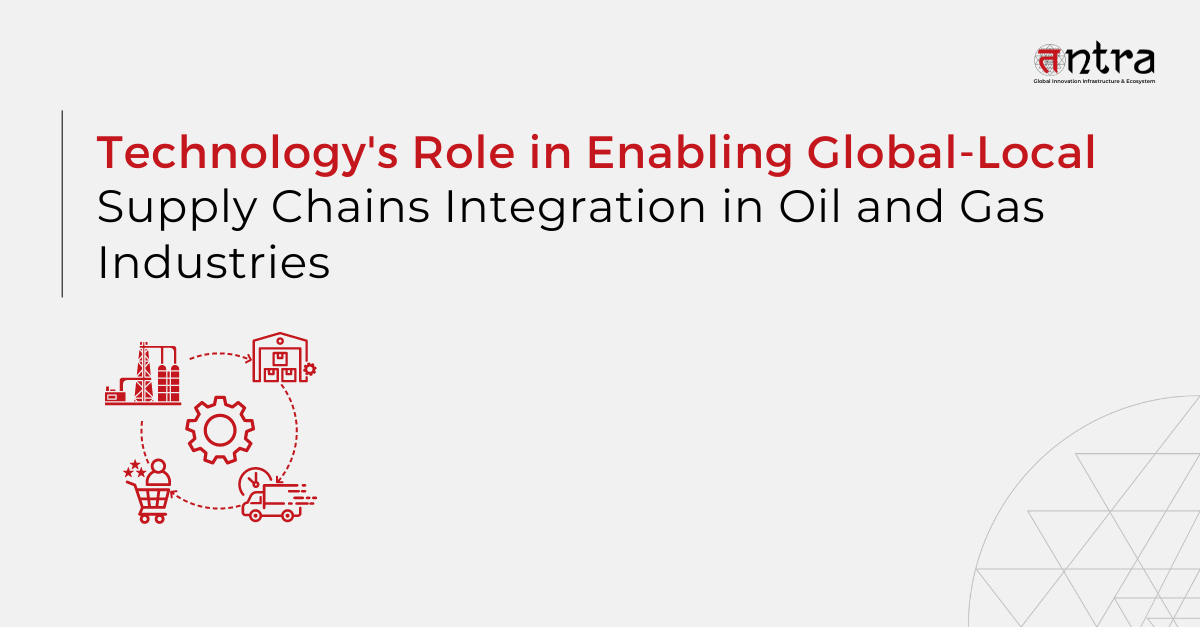
Technology’s Role in Enabling Global-Local Supply Chains Integration in Oil and Gas Industries
Table of Contents
ToggleTechnology is bringing about a transformation in supply chain management within the oil and gas industry. Businesses are using Industrial Internet of Things (IIoT) sensors to gather data in real-time and improve decision-making and operations. Robotic process automation (RPA) brings process efficiency, while predictive maintenance minimizes downtime and costs. Blockchain improves compliance and material tracking, while mobile devices give employees rapid access to data. With the industry’s attention shifting to sustainability, these advances are critical to boosting the robustness and efficiency of international supply chains. Continue reading to learn more.
With more than 160 ongoing AI initiatives, Shell has integrated AI throughout its whole oil and gas industry supply chain. In order to lower the cost of gas extraction, it applies reinforcement learning in its exploration and drilling program. Drill operators can accelerate results and cut maintenance and expenses by using automated drilling systems that are based on simulation and data acquired by Shell. Data scientists and AI engineers can gain exposure with multiple AI projects across the organization through Shell’s AI Residency Program.
Since 2017, BP, a different big oil player in Europe, has worked with Microsoft to deploy its Azure cloud solutions, which include machine learning (ML) for more intelligent drilling procedures. BP was able to switch all of its data centers to Azure because of this relationship. Drilling time has been greatly decreased since it expedited data analytics in oil & gas and allowed for quicker, more sensible judgements.
(Source: Offshore Technology)
Technology in Supply Chain: An Upward Trend
Technology is cited as a source of competitive advantage by 61% of supply chain companies, and 20% of them cited emerging technologies as crucial areas for investment.
Statista projects that by 2025, the rate of artificial intelligence (AI) usage in the supply chain management will have increased by 45.55%. This expansion is likely to occur in enterprises working in supply networks and industrial industries worldwide.
67% of supply chain executives have adopted digital dashboards for end-to-end supply chain monitoring, according to a recent McKinsey report. The visibility of the supply chain has significantly improved with this digital transformation, which is important for handling supply chain interruptions.
How Technology Advances Global Oil & Gas Supply Chains
Oil and gas businesses are working to modernize their operations in order to stay competitive. They want to lower costs and emissions while increasing asset availability and dependability. It is acknowledged by leaders that substantial improvements must be made in each of these areas, beyond the small adjustments that define past best practices.
To be sure, a lot of CEOs think that digitisation is the key to achieving their desired advantages. Over the last ten years, developments in data analytics, artificial intelligence (AI), and the Industrial Internet of Things (IIoT) have aided participants in numerous industries in streamlining intricate procedures, locating elusive sources of inefficiency and loss, and improving their ability to react to shocks, volatility, and disruptions.

Here’s how technology has transformed global oil & gas supply chain management:
- Monitoring real-time data with IoT
IIoT sensors can be used at every stage of the value chain, from production and exploration upstream to midstream transportation and downstream processing. By gathering data in real-time on safety indicators, environmental conditions, and equipment performance, these sensors help businesses optimize their operations and make data-driven decisions. In its Prelude floating liquefied natural gas (FLNG) facility, for instance, Shell has deployed IIoT-based digital transformation solutions, which have resulted in a 20% reduction in maintenance costs and a 5% increase in production efficiency. - Predictive maintenance in supply chain
Predictive analytics and maintenance are another significant area in which supply chain management software solutions are revolutionizing the oil and gas sector. The massive volumes of data (gathered by IIoT sensors) can be analyzed using cutting-edge algorithms and machine learning to forecast equipment faults. In the energy industry, it not only lowers maintenance expenses and downtime but also aids in supply chain management. Predictive maintenance in the oil and gas industry can save maintenance costs by 10–40% and boost output by 5–20%, per a Deloitte study. Predictive maintenance solutions are already being used by major oil and gas corporations like BP and Chevron; according to BP, these solutions have reduced maintenance costs by 20% and increased production efficiency by 10%. - Automating supply chain activities
In the oil and gas industry, automating the closure process with robotic process automation (RPA) can drastically cut down on closing time, lower the possibility of human error, and enhance audibility. RPA can be used to automate procurement transactions in oil and gas supply chains, resulting in faster cycle times and increased overall efficiency. In offshore drilling, the inspection of inaccessible places is automated through the employment of drones and underwater robots. In dangerous areas, bots can also lower mistakes and improve worker safety when replacing or repairing damaged parts. - Tracking material movement
Making sure that resources are traceable and secure is one of the problems facing the oil and gas sector. An emerging countermeasure to this asset tracking technique is blockchain technology. Real-time material tracking is made possible by blockchain-based systems and supply chain software development services, which lowers the possibility of loss, manipulation, or theft. They also offer transaction records that cannot be altered. It guarantees adherence to industry norms and legal obligations. Research projects that the worldwide blockchain market for the oil and gas industry will reach $3.4 billion by 2025, growing at a compound annual growth rate (CAGR) of 60.8% from $0.3 billion in 2020. - Workforce mobilization
The modern worker is more mobile than before. Top performers in the oil and gas industry are giving their employees mobile devices to boost productivity and agility. For instance, employees can find the parts and paperwork for a maintenance work order in the field by using ruggedised mobile devices. Using mobile barcoding in a warehouse or production plant helps expand ERP capabilities to the point of work. Real-time visibility is made possible by employees processing transactions instantaneously by scanning materials or inventory in any place.

Final Thoughts
The oil and gas sector is under growing pressure to implement sustainable practices as the energy landscape changes quickly. This transition is greatly aided by technology, which is fostering sustainability, efficiency, and innovation throughout the value chain. Cutting-edge software product engineering services and technologies are changing how oil and gas firms track and monitor their operations, from IIoT and predictive analytics to blockchain and augmented reality.
Tntra expertise in implementing supply chain software product engineering solutions is unmatched. From monitoring assets to tracking the flow of goods, we can integrate technology at every phase and streamline your supply chains. Schedule a call to get started today!





